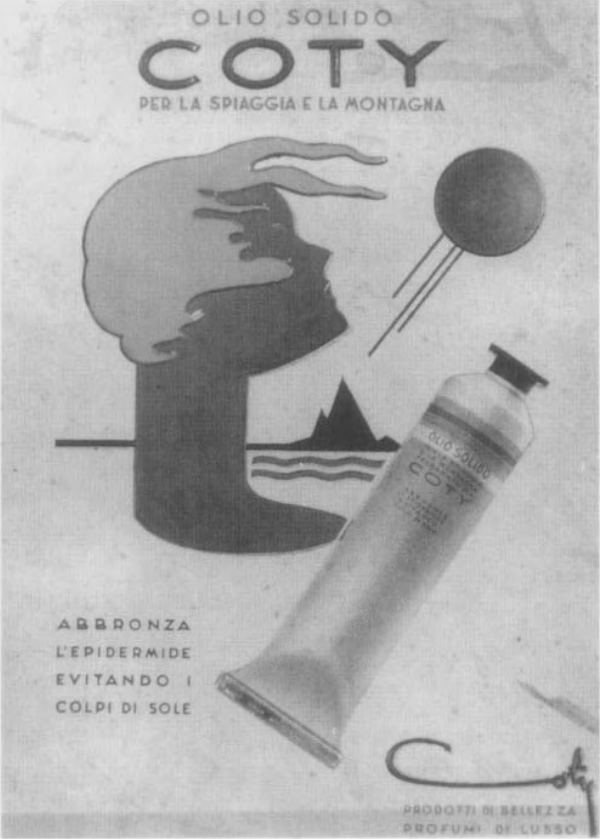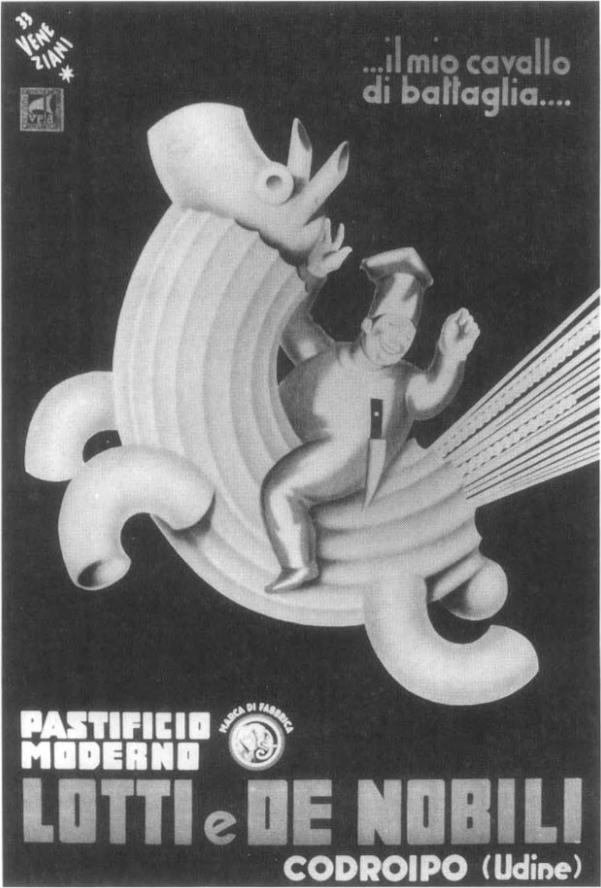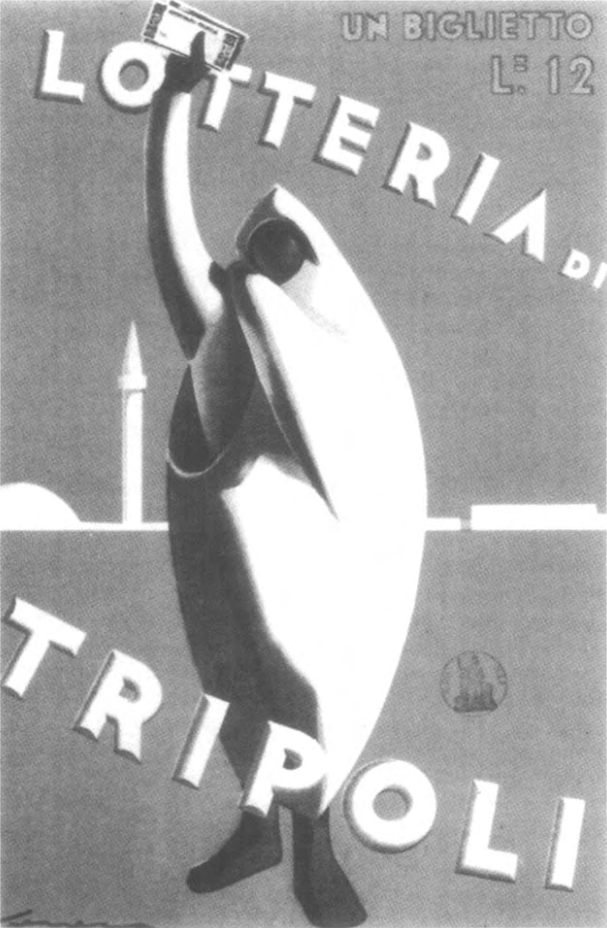(Mirror.)
Despite some Fascists criticizing American‐style advertising, a great deal of the advertising under Fascism still owed its origins to Imperial America anyway:
Similarly, new products like gas stoves, rice, and bananas were popularized, through often heavily publicized educational campaigns where modern forms of use were encouraged (Quaglia 2000). Together with rationalist architecture, modern consumer goods should contribute to shape a material environment conducive to a modern life that was both distinctly fascist, illuminated by the values of a reborn national character, and distinctly middle class — a material environment that would contribute, as Mariuccia Salvati (1993: 112) argues, to both a “civilization” and a nationalization of the masses.
It followed that it was important to employ modern, often American, theories and methods like Taylorism, in a way that was respectful of and indeed strengthened what was diffusely defined as an Italian national character. They had to be used, as the earlier quote here indicates, “the Latin way” in order to contribute to what Giuseppe Bottai (1930), writing in L’ufficio moderno, defined as an “Italian form of rationalization” (una razionalizzazione italiana), guided by the concerns of the nation rather than by the interests of particular groups or formations.
[…]
As pointed out in the journal of the enthusiastic advertising pioneer Ernesto D’Angelo, L’idea, in 1917, advertising was about “giving birth to your own ideas in other people's heads.”24 More so, as a how‐to article claimed 10 years later, a repetitive message should enter the consumer's mind “like a thief in the night” and “neutralize his brain” (“Come fare un annuncio” 1927). It could “make the name of a large manufacturer penetrate the brains of a million men” (“Secondo Incisa” 1927).
Advertising was thus about presenting people with objects, or representations of objects, that they, by virtue of their bon foi, would immediately desire. Apart from the caution not to advertise objects beyond people's financial means, like luxury cars to workers, any object could in principle be made needed or wanted by anyone. Through repetition, the suggestive effects of the advertising message would build up in the consumer's mind to, in the end, create a want or need that he did not have before.
As the journalist Arturo Lancelotti (1912: 55), who wrote one of Italy’s first volumes on advertising (a combined history and how‐to manual) imagined the process: “Every morning when he opens the newspaper and every week when he dives into his illustrated magazine, every month when he looks into his monthly review, he sees the same order repeated: ‘Take a piece of soap home with you tonight!’ And one night, when he’s in a hurry, without thinking of what he’s doing, he enters the nearest shop and exclaims, ‘Give me a bar of Soper Soap [sic].’ The order, repeated all around him, has fulfilled its secret task; it has given him the necessary psychological impulse and, goddamn it, you have got yourself, a customer.”
[…]
The revaluation of the lira in 1927 forced many previously export‐oriented manufacturers to turn to the home market, where they relied on advertising to sell their products (Sapelli 1978a). With the exception of the years immediately following the Depression, this expansion of the national market for mass‐produced branded and advertised goods continued.
In connection with the proclamation of “autarchy” in 1936, many manufacturers, including foreign ones, were quick to reposition their goods, through advertising, as Italian products. (Lever Brothers, for example, launched a rather massive campaign in 1935 claiming that its soap, Palmolive, was made of “Italian olive oil.”)
As the demand for advertising increased, so did the supply of advertising space. The media system expanded, and a number of weekly magazines emerged (including cooking magazine Cucina Italiana [1928], upscale design magazines Domus and Casabella [both 1928], and American‐style women's magazines such as Lei [1933; later called Annabella (when lei as a form of polite address was banned)] and Gioia [1937]).
These magazines relied extensively on advertising revenue, and they dedicated much of their editorial content to the thematization of consumption (Lilly 1976; de Grazia 1992; Passerini 1994). They addressed more limited segments of the public, and, in some instances, as in the case of the sports paper Gazzetta dello sport (1934), they marketed their audiences to advertisers as particular consumer segments.
In part, the advertising profession itself changed. The advertisers founded a professional association that was recognized by the régime in 1928 as the National Fascist Syndicate of Advertising Agencies and Companies (Sindacato Nazionale Fascista Agenzie e Case di Pubblicità).
[Fascist] advertisers participated in international conferences, and in 1933 Italy hosted the conference of the Continental Advertising Association, a propaganda spectacle of some importance, with speeches by Mussolini and visits to the permanent exhibition of the fascist “revolution” (Valeri 1986).
At the conference, the size of the Italian advertising profession was estimated to be 802 companies, agencies, and offices, and its turnover was estimated to be about 300 million lire, roughly the same as in 1949 (“Atti del congresso internazionale della pubblicità” 1933).25 By the mid 1930s, advertising had become a recognized profession, and courses in advertising were regularly taught at the Milan polytechnic, as well as at a number of professional schools.
The most significant development, however, was the emergence of advertising agencies, where advertising technicians worked together with artists and designers according to a coordinated overall strategy.
The advertising agency was an American invention (the preexisting advertising companies or “houses” (case di pubblicità), like Magagnoli’s Maga, were more like artist’s collectives).
In addition to J. W. Thompson’s short experience in Milan in 1927 and the Milan subsidiary of the New York agency Erwin Wasey & Co. (which opened in 1928 with the accounts of American multinationals: Palmolive, Ford, Frigidaire, Camel, and Texaco), all the advertising agencies that opened in Italy during the 1930s were started by people who had some kind of working experience in the United States.
Luigi Dalmonte, who in 1922 founded Italy’s first agency, ACME‐Dalmonte, had worked for the then‐famous George Ethridge agency in New York. Pier Luigi Balzaretti, who together with Giulio Cesare Ricciardi founded Balza‐Ricc in 1931, had been at the advertising office at Macy’s in San Francisco. Nino Caimi, who founded Enneci in 1931, had both lived in the United States and managed Erwa, Erwin Wasey's branch in Milan.26
With the advertising agency came a new, equally American method: the advertising campaign. Instead of concentrating on the aesthetic qualities of the single ad, advertisers now emphasized the necessity of coordinating ads in different media: newspapers, weekly magazines, posters, shop windows, even theater groups and, beginning in the early 1930s, radio, to create campaigns that were integrated around a central theme, a central, as the American term went, “product benefit” (Dalmonte 1947).
(Emphasis added.)
For a philosophic examination of Fascist advertising, see Karen Pinkus’s Bodily Regimes: Italian Advertising under Fascism. The following samples and their descriptions come from that book:

Coty skin cream ad. (Salce Collection, 23870.)

Pastificio Moderno white homunculus. (Salce Collection, 00791.)

Pirelli trench coats. (Salce Collection, 03810.)

Veiled Arab by Seneca. (Salce Collection, 08507.)

‘I am coffee.’ Gino Boccasile's coffee bean‐head. (Salce Collection, 3096. Unlike the other images, I was able to find a high quality scan of this advert; this one did not come directly from Pinkus’s book.)
You’ve no doubt noticed how a few of these samples feature African figures. It is opportune to remind you that Fascist Italy held colonies in Africa (Eritrea, Libya, Somalia, and later, Ethiopia), and Fascist advertisers liked using African caricatures to emphasize a product’s ‘exotic’ (and therefore ‘special’) nature: the Fascists imported products such as furs, coffee, chocolate, and bananas from their colonies.
Click here for events that happened today (February 23).
1919: Benito Mussolini founded the Partito Nazionale Fascista.
1932: The Imperialists’ light carrier Hosho launched aircraft to attack airfields near Hangzhou, China.
1933: The Third Reich’s Chancellor announced his wish to gain Lebensraum (living room) for the German folk.
1937: Heinrich Himmler issued the directive scheduling an arrest of about 2,000 ‘professional and habitual criminals’ on 9 March 1937; his fellow anticommunists were to send them to concentration camps.
1939: The Imperialists lost six bombers over Lanzhou, Gansu, China.
1940: Curiously, the Fascists removed the Imperial Regalia of the Holy Roman Empire, including relics of Christian mythology, from public display in Nürnberg. They moved them after dark to a secret location for safe storage. Coincidentally, the Fascists lost their submarine U‐53.
1941: Joachim von Ribbentrop hosted Hiroshi Oshima in his home in the Reich, where Ribbentrop attempted to persuade the Imperial ambassador that it was the time for the Empire of Japan to strike British territories in Asia. Ribbentrop argued that there was little worry regarding the United States as Yankee possessions in Asia could be bypassed easily, but should the Yankees decide to go to war, the Imperial Japanese Navy was vastly superior to the U.S. Navy. That aside, while the Axis did lose its ship Silvia Tripcovich fifty miles off Sfax, Tunisia, the Axis still sunk a British monitor early that morning, and an Axis Fw 200 Condor aircraft led submarines U‐69, U‐73, U‐96, U‐107, U‐123, Bianchi and Barbarigo to Allied convoy OB‐288 three hundred miles south of Iceland. Just before midnight, U‐69 sank British ship Marslew (slaughtering thirteen to the exclusion of twenty‐three) and U‐96 sank British ship Anglo‐Peruvian (massacring twenty‐nine to the exclusion of seventeen). U‐107 and Bianchi damaged and chased British ocean boarding vessel HMS Manistee through the night. (This is another good example of coordination between the German and Italian Fascists.)
1942: Berlin named Erwin Rommel the commanding officer of Heeresgruppe Afrika, and somebody informed Hans‐Joachim Marseille that he was to be awarded the Silver Medal of Military Valor of Italy. As the war games conducted by Rear Admiral Matome Ugaki aboard Yamato completed, Ugaki noted that a simulated attack on British Ceylon had failed. Nevertheless, Axis aircraft struck Allied airfields on Java, Dutch East Indies. Meanwhile, Colonel William Leggatt’s Australian troops surrendered at Koepang, Dutch West Timor at 0900 hours, while the Australian troops outside of Koepang were bombed by Axis aircraft at 1000 hours. The Axis’s cruiser Prinz Eugen (barely) survived an Allied torpedo while Axis submarines U‐129 and U‐502 sank an Allied freighter and a tanker, respectively.
1943: The Axis brought thirty‐nine Jewish prisoners from Auschwitz II‐Birkenau to Block 20 of Auschwitz I in occupied Poland. SS‐Unterscharführer Herbert Scherpe injected these prisoners, aged 13 to 17 and originally from the Zamosc region of Poland, with phenol injections, massacring them. Apart from that, Erwin Rommel ordered his forces in western Tunisia to move east to avoid being attacked on both sides, and Axis U‐boats using acoustic homing torpedoes sank seven tankers in a North Atlantic convoy. Axis installations in the Mariana Islands, however, suffered an aerial attack from the Allies.
1944: Three Axis motor torpedo boats attacked the Allied beachhead at Anzio, Italy before dawn, causing no damage and losing two boats, and the Axis lost its submarine U‐713 and all 50 aboard near Allied convoy JW‐57.
1945: The Axis lost its Verona Philharmonic Theatre in Italy to Allied bombing, and the Axis also lost Fortress Posen (now Poznan, Poland) to the Soviets after a mensual siege. Berlin made Oberleutnant zur See Joachim Sauerbier U‐56’s commanding officer of, relieving Heinrich Miede. Twenty‐three Ju‐88 bombers attacked an Allied convoy from Murmansk in northern Russia to Scotland. The Axis lost three bombers and two experienced significant damage, but eventually it sunk the Allied ship Henry Bacon and twenty‐three of its crew. This was the last time that the Reich sunk an Allied vessel. The Axis’s town of Pforzheim, in what was likely to be one of the Allies’ most controversial decisions, lost 17,000 people and at least 80% of its buildings to Allied aircraft. Rail facilities at Plauen likewise suffered an Allied bombing raid.
1946: The Axis lost General Yamashita to Allied hangmen at Los Banos Prison Camp near Manila.
I always find it really funny that Italy tried to invade Ethiopia twice and both times they got their shit kicked in.


